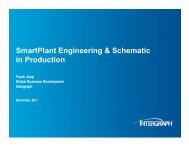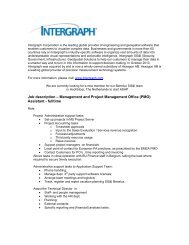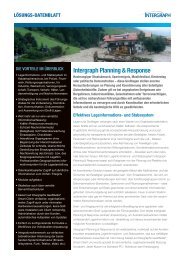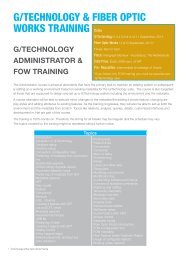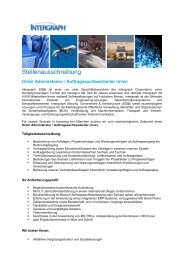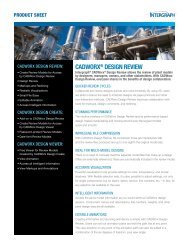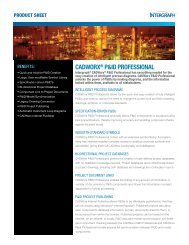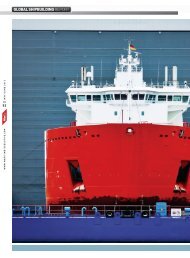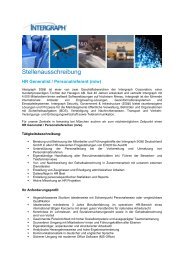Read the Nuclear Industry Spotlight - Intergraph
Read the Nuclear Industry Spotlight - Intergraph
Read the Nuclear Industry Spotlight - Intergraph
You also want an ePaper? Increase the reach of your titles
YUMPU automatically turns print PDFs into web optimized ePapers that Google loves.
SmartPlant Review suite has been used extensively<br />
to review <strong>the</strong> plant in an integrated fashion,<br />
and also for constructability. The benefits of 3D<br />
visualization don’t have to end with engineering<br />
and construction of a plant. The 3D models and<br />
data generated by visualization tools can be used<br />
as part of training, operations and maintenance,<br />
realizing both cost- and time-saving benefits.<br />
The AP1000 provides a high degree of public<br />
safety and licensing certainty. It draws upon more<br />
than 40 years of experience in light water reactor<br />
components and technology, so no demonstration<br />
plant is required. While clearly advanced in its<br />
application of passive safety features, <strong>the</strong> AP1000<br />
is still based on <strong>the</strong> very same Westinghouse PWR<br />
technology that has accumulated thousands of<br />
reactor-years of successful operation internationally<br />
since <strong>the</strong> first PWR went online in Shippingport,<br />
Pennsylvania U.S. in 1957.<br />
The AP1000’s predecessor, <strong>the</strong> AP600, was<br />
designed with input from more than 30 engineering<br />
organizations from around <strong>the</strong> world.<br />
The AP1000 also had international collaborators.<br />
Previously, <strong>the</strong> collaboration was performed at each<br />
organization, and integrated into Westinghouse’s<br />
controlling model by manual integration. Since<br />
that time, <strong>Intergraph</strong> products have become more<br />
capable of workshare and collaboration. They<br />
enable Westinghouse to perform detailed design<br />
work around <strong>the</strong> world, and <strong>the</strong> modular design<br />
of <strong>the</strong> plants allows suppliers to work globally and<br />
have all <strong>the</strong> pieces fit toge<strong>the</strong>r when joined at <strong>the</strong><br />
plant site.<br />
Certainly <strong>the</strong> time is right for <strong>the</strong> U.S. to renew<br />
its focus on nuclear power generation. In fact, a<br />
number of utilities have submitted applications<br />
to <strong>the</strong> U.S. <strong>Nuclear</strong> Regulatory Commission in<br />
preparation for building a plant. The Energy Policy<br />
Act of 2005 focuses on lowering <strong>the</strong> country’s<br />
foreign and fossil fuel dependence, with many<br />
significant incentives intended to grow <strong>the</strong> U.S.<br />
nuclear industry.<br />
More and more political, business and environmental<br />
leaders are speaking out on <strong>the</strong> advantages of<br />
nuclear power as <strong>the</strong> cleaner, cheaper, and yes,<br />
safer power generation alternative. In an article<br />
published April 14, 2006 in The Washington Post,<br />
Greenpeace co-founder Patrick Moore says,<br />
“<strong>Nuclear</strong> energy may just be <strong>the</strong> energy source that<br />
can save our planet from ano<strong>the</strong>r possible disaster:<br />
catastrophic climate change.” He continues, “More<br />
than 600 coal-fired electric plants in <strong>the</strong> United<br />
States produce 36 percent of U.S. emissions –<br />
or nearly 10 percent of global emissions – of CO2,<br />
<strong>the</strong> primary greenhouse gas responsible for climate<br />
change. <strong>Nuclear</strong> energy is <strong>the</strong> only large-scale,<br />
cost-effective energy source that can reduce <strong>the</strong>se<br />
emissions while continuing to satisfy a growing<br />
demand for power. And <strong>the</strong>se days it can do<br />
so safely.”<br />
In 2001, <strong>the</strong> nuclear energy industry announced<br />
its goal of preserving <strong>the</strong> existing percentage of<br />
America’s emission-free electricity, while at <strong>the</strong><br />
same time adding new electricity generation.<br />
Vision 2020 specifies having enough new nuclear<br />
power plants ei<strong>the</strong>r under order, under construction<br />
or already built to provide 50,000 MW of<br />
additional electricity-generating capacity to <strong>the</strong><br />
U.S. power grid by 2020.<br />
Vision 2020 also calls for <strong>the</strong> addition of ano<strong>the</strong>r<br />
10,000 MW capacity of nuclear power by modifying<br />
existing plants with more efficient equipment<br />
and more accurate instrumentation so <strong>the</strong>y can<br />
produce more electricity, and by operating current<br />
plants more efficiently so <strong>the</strong>re is less time when<br />
<strong>the</strong> reactor is not producing full power. Toge<strong>the</strong>r<br />
with o<strong>the</strong>r renewable production, <strong>the</strong>se increases<br />
will maintain <strong>the</strong> non-emitting percentage of<br />
electricity produced in <strong>the</strong> U.S. at 30 percent,<br />
continuing to help keep our air clean.<br />
It’s imperative to plan for ra<strong>the</strong>r than react to<br />
increases in future energy requirements. The<br />
AP1000 has been confirmed as <strong>the</strong> technology<br />
base for 10 combined construction and operating<br />
license applications. Among <strong>the</strong> utility companies<br />
considering expanding <strong>the</strong>ir nuclear capabilities are<br />
South Carolina Electric & Gas (principal subsidiary of<br />
SCANA Corporation), Duke Power, Progress Energy<br />
and <strong>the</strong> team of Sou<strong>the</strong>rn Company and Georgia<br />
Power. Late last year, NuStart, <strong>the</strong> nation’s largest<br />
consortium of nuclear power companies, selected<br />
TVA’s Bellefonte nuclear plant site for a combined<br />
construction and operating license (COL) application<br />
for <strong>the</strong> AP1000.<br />
The AP1000 is ideally suited for <strong>the</strong> worldwide<br />
nuclear power marketplace. Not only is it <strong>the</strong> safest,<br />
most advanced design available, but its modular<br />
design promotes ready standardization and high<br />
construction quality. Its 1100 MWe design is ideal<br />
for providing baseload- generating capacity. It’s<br />
economical to construct and maintain because it<br />
requires less concrete and steel and fewer components<br />
and systems. It’s designed to promote<br />
ease of operation and features <strong>the</strong> most advanced<br />
instrumentation and control in <strong>the</strong> industry.<br />
In <strong>the</strong> past, <strong>the</strong> high cost and long-term build-out<br />
schedules for nuclear power plants discouraged<br />
many countries from focusing on this type of<br />
power generation. Westinghouse is addressing<br />
both of <strong>the</strong>se issues with <strong>the</strong> AP600 and<br />
AP1000. By using modular construction methods,<br />
Westinghouse and its project partners will be<br />
able to build <strong>the</strong> AP1000 in 36 months. This is<br />
one-fourth to one-half <strong>the</strong> customary construction<br />
time of <strong>the</strong> most recent U.S. nuclear plants. Using<br />
<strong>Intergraph</strong>’s SmartPlant Review, Westinghouse<br />
shortened <strong>the</strong> construction cycle, ensuring <strong>the</strong><br />
buildability of <strong>the</strong> plant as designed and using <strong>the</strong><br />
model as an informational tool for both technical<br />
and non-technical audiences.<br />
The price of fossil fuels, pending clean air regulations<br />
and increasing concerns about dependence<br />
on foreign oil suppliers will continue to encourage<br />
renewed interest in nuclear power generation.<br />
Taking into consideration that <strong>the</strong> newest technology<br />
allows significant cost reductions in plant<br />
construction, as well as streamlined build-out<br />
time and licensing procedures, nuclear power is<br />
<strong>the</strong> obvious choice for <strong>the</strong> future. Westinghouse<br />
is proud to be at <strong>the</strong> forefront of this exciting<br />
renaissance in nuclear power generation.<br />
Jill Clelland is information management lead<br />
for passive plant development at Westinghouse<br />
Electric Co. LLC.<br />
www.westinghousenuclear.com<br />
<strong>Nuclear</strong> <strong>Industry</strong><br />
Insight<br />
3




